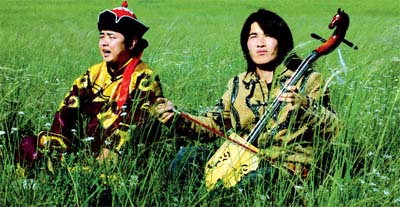Mongolian throat singing rocks the world
 |
|
Hoomii singers vocalize in Inner Mongolia. [Global Times] |
Hoomii, also known as Mongolian throat singing, is an ancient musical art dating back a thousand years. The exquisite art form has been brought back to life on the Chinese rock scene, where the mysterious sound has been blended into electric guitar rhythms.
You hear hoomii in several recent movie soundtracks, including the most recent Chinese blockbuster “Bodyguards and Assassins,” the historical epic “Mongol,” a German- Kazakhstan-Russian-Mongolian co-production, and in the arthouse film “Mongolian Pingpong” by avant-garde Chinese filmmaker Ning Hao.
Hoomii is also popular on TV, as well as in trendy bars and performance venues across China.
The sound imitates the ripples of a stream or an echo in the mountains. Throat singing produces two simultaneous vocal tones in the human voice and therefore is considered a great skill.
For the past 100 years, this original art form was on the edge of extinction on the vast Inner Mongolian plateau.
Nowadays, the talent is perfected by only a few singers in Inner Mongolia and Central Asia, notably in the Tuvan Republic and among certain other ethnic groups in the Altai Mountains. On October 1, 2009, Mongolian Hommii of China was successfully listed as an intangible cultural heritage by UNESCO.
"Hommii is one of the most ancient and precious arts in the cultural heritage of mankind," said musicologist Moerjihu.
"This unique art form captures the essence of Mongolia, the sound of nature, the nomadic lifestyle, and the expression of a free spirit."
Since the 1990s, Chinese musicians and music scholars have attempted to preserve throat singing through extensive musical exchange programs with neighboring countries.
Hoomii has also been introduced in the curriculum of music academies. Meanwhile, indie bands and rock groups have taken the art form to a new level.
 0 Comments
0 Comments







Comments